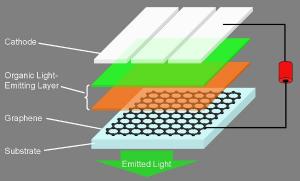Researchers at Stanford University have successfully developed a brand new concept of OLEDs with a few nanometer of graphene as transparent conductor. This paved the way for inexpensive mass production of OLEDs on large-area low-cost flexible plastic substrate, which could be rolled up like wallpaper and virtually applied to anywhere you want. The researchers say that Graphene has the potential to be transparent, high-performance, highly conductive and cheaper by several orders of magnitude than current ITO based solutions. Interestingly just a few weeks ago we reported that Graphene can be used to make organic lighting devices, too.
 Graphene OLED
Graphene OLEDTraditionally, indium tin oxide (ITO) is used in OLEDs, but indium is rare, expensive and difficult to recycle. Scientists have been actively searching for an alternative candidate.
The next generation of optoelectronic devices requires transparent conductive electrodes to be lightweight, flexible, cheap, environmental attractive, and compatible with large-scale manufacturing methods. Graphene (a single layer of graphite) is becoming a very promising candidate due to its unique electrical and optical properties. Very recently, Junbo Wu et al., researchers at Stanford University, successfully demonstrated the application of graphene in OLEDs for the first time.
Junbo Wu, leading researcher of the development, said that they achieved OLEDs on graphene with performance similar to a control device on conventional ITO transparent anodes, which is very exciting and promising for real-world applications. Because Graphene is only a couple of nanometers thick, it can give device designers more freedom.
For detailed information on this research, please refer to http://pubs.acs.org/doi/abs/10.1021/nn900728d.

